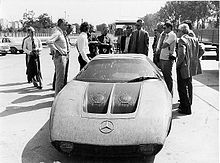- Mercedes-Benz C111
-
 C111 at the Mercedes-Benz Museum
C111 at the Mercedes-Benz Museum
The C111 was a series of experimental automobiles produced by Mercedes-Benz in the 1960s and 1970s. The company was experimenting with new engine technologies, including Wankel engines, Diesel engines, and turbochargers, and used the basic C111 platform as a testbed. Other experimental features included gullwing doors and a luxurious interior with leather trim and air conditioning.
The first version of the C111 was completed in 1969. It used a fiberglass body shell and had a three-rotor direct fuel injected Wankel engine (code named M950F) mounted in the middle. The next C111 appeared in 1970. It used a four-rotor engine producing 370 hp (275 kW). The car could reportedly hit 290 km/h (180 mph).
The company decided not to adopt the Wankel engine and turned to Diesel experiments for the third C111. With its 230 horsepower (170 kW)@ 4,400-4,600 5-speed manual straight-5 turbo-Diesel, the C111 broke nine diesel and gas speed records. With more aerodynamic bodywork that gave it an air drag coefficient of an incredible .191, the C111 eventually hit 200 mph (322 km/h) at Nardò in 1978, and averaged 14.7mpg@ 316 km/h (195.4 mph) over a 12 hour cruise. A later 500 hp (372 kW) 4.8 L twin KKK-turbocharged V8 version set another record, with an average lap-speed of 403.78 km/h (250.958 mph). It was achieved by Dr. Hans Leibold in 1 minute, 56.67 seconds on May 5, 1979.
Mercedes-Benz introduced the C112 at the Frankfurt Motor Show in 1991 as a production sports car. It used a 6.0 L V12 engine mounted in the middle. But after accepting 700 deposits, the company decided not to proceed with production.
External links
- eMercedesBenz Feature: A Look Back At The Mercedes-Benz C 111 Research Vehicle July 31, 2008
- C111 III Picture gallery
- Some information (in french) and pictures of all C111 versions
Categories:- Mercedes-Benz vehicles
- Vehicles with Wankel engines
- Automobiles with gull-wing doors
- Sports cars
Wikimedia Foundation. 2010.

